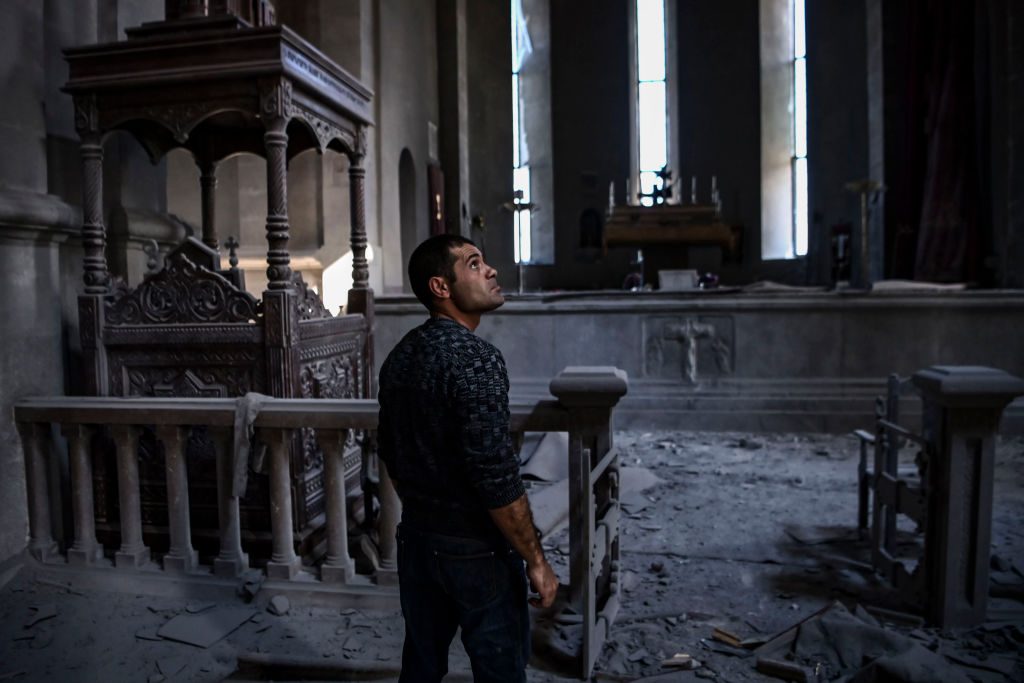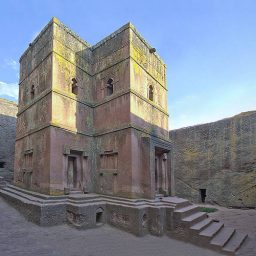A Russian-brokered ceasefire agreement last month ended weeks of bitter fighting between Armenians and Azerbaijanis over the disputed region of Nagorno-Karabakh. The regain and loss of territory in the region highlights the disputed status of an archipelago filled with medieval Armenian churches, as well as tombs, mosques, and mausoleums, which comprise the rich cultural heritage of this region.
The roots of the Armenian-Azerbaijani conflict lie in disputes over the past and its culture as well as the present. In clashes that are familiar in disputes from Northern Ireland to the Balkans to the Middle East, the parties assert competing claims of attachment over particular lands—and of who gets to tell their stories.
In these bitter arguments, nationalist scholars deny the aspirations of their opponents. Maximalist doctrines give license to the erasure of the other side’s markers of cultural identity and allow for the destruction of heritage and cultural memory. More must be done to protect the living histories of this place for everyone.
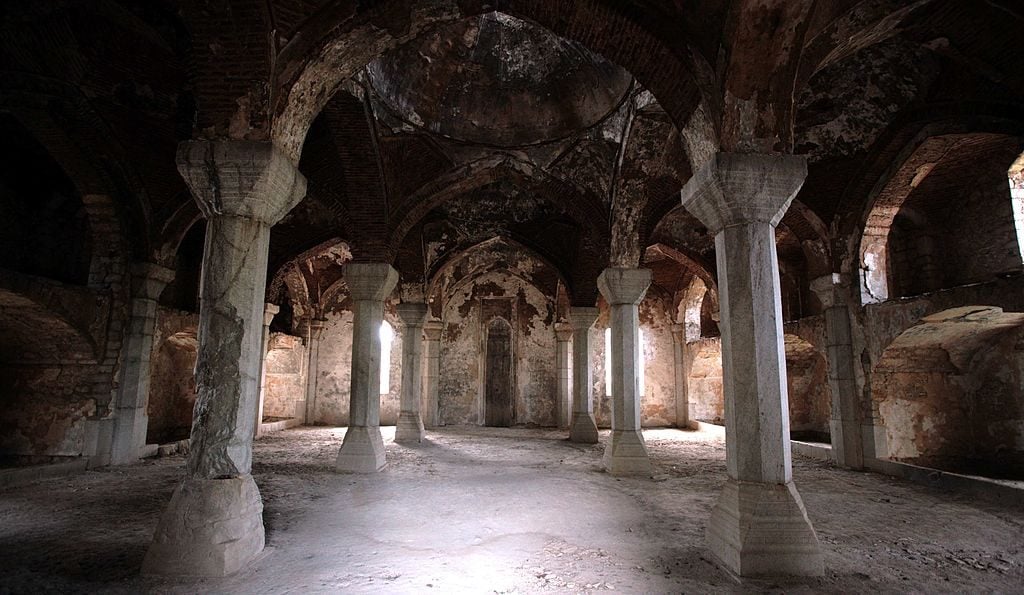
The interior of a damaged mosque is seen in Shushi in 2007. Photo: Matthias Schumann/Getty Images.
This Recent, Painful Chapter
In this most recent chapter of the Karabakh conflict, which came to a close on November 10 after six weeks of fighting, Azerbaijan prevailed on the battlefield. Faced with a military defeat, Armenians were forced to hand over seven districts of Azerbaijan that they had controlled for more than 25 years. This allows for the return of more than half a million displaced Azerbaijanis to their homes; it also means that around 30,000 Armenians in parts of Karabakh that have been retaken by Azerbaijani forces are newly displaced. The total human price of this conflict has been enormous: the current death toll stands at about 6,000 lives.
To be sure, this pause is not a peace agreement, but a much-needed truce that still leaves unresolved an underlying dispute over Karabakh, an Armenian-majority region that tried to break away from Azerbaijan at the end of the Soviet era in the 1990s. Much of the heritage in this area is ancient, beginning with one of the world’s most prehistoric sites, the Azykh cave. While its 300,000-year-old origins can mostly be agreed upon, the significance of other ancient sites has been questioned for the sake of nationalist arguments.
Displaced Azerbaijanis returning to those lands last month were shocked to discover that not only their former houses, but also graveyards had been wrecked during the Armenian-controlled decades. In some cases, mosques were preserved but used to house animals. Armenians visited enormous destruction on the Azerbaijani regions they occupied, leaving whole settlements, such as the town of Aghdam, once home to 30,000 people, in ruins.
In this very same region, some of the most precious Armenian monuments date from a Golden Age during the 12th and 13th centuries, when the Armenian feudal lords built the churches of Gandzasar, Dadi Vank and Gtichavank. These are little-known treasures still standing today and they are adorned with sculptures, frescoes, and medieval Armenian inscriptions.
Two of these churches, Dadi Vank and Gtichavank, as well as smaller churches in the Hadrut region, are now coming under Azerbaijani control again. The prospect of their complete erasure seems unlikely, but there is one deeply worrying precedent in recent history. A major act of cultural vandalism was committed in Nakhichevan, an exclave of Azerbaijan in the 1990s and 2000s, when all Armenian cultural monuments there, including many medieval churches, were destroyed by Azerbaijan. Most outrageously, the famous Jugha cemetery, containing thousands of carved Armenian cross-stones khachkars dating to the 13th to 16th centuries, was also completely erased.
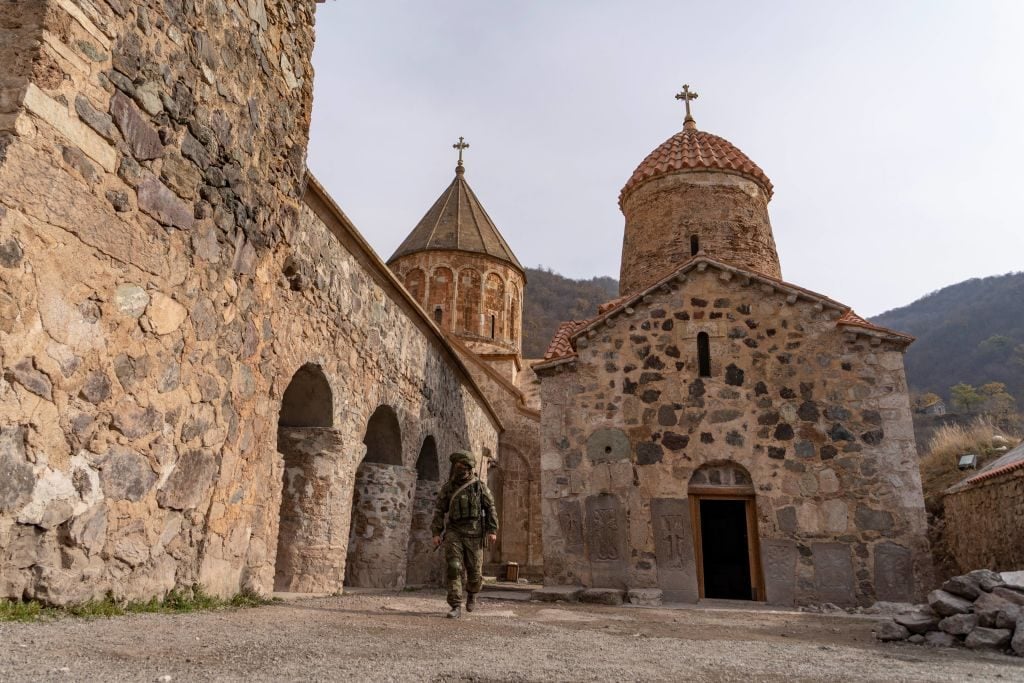
A Russian peacekeeper walks past the 12th-13th century Orthodox Dadivank Monastery, outside the town of Kalbajar. Photo: Andrey BORODULIN/AFP via Getty Images)
The Weight of the Past
These Armenian sites in and around Karabakh are now at risk of at least partial erasure and tendentious restoration. For years, the Azerbaijani Ministry of Culture has been repeating a bizarre historical theory—that all the Armenian church monuments in and around Karabakh are not Armenian at all, but actually “Caucasian Albanian,” and that therefore Armenians somehow have no right to claim them as their historical legacy.
The theory, which has little currency outside of Azerbaijan, is heavily political. It dates back to the post-Stalin Soviet period when the controversial nationalist Azerbaijani historian Zia Buniatov identified the Caucasian Albanians, a small Christian people with no relation to the Balkan-based Albanians, as the ancient forebears of Azerbaijanis.
While the Caucasian Albanians had mostly been assimilated into other groups more than a thousand years ago, “Albanian” remained the name for one branch of the Armenian church in the region until the 19th century. This detail was enough to fuel the provocative thesis that the rich Christian medieval heritage in and around Karabakh is “not Armenian.” The Azerbaijani government still advocates this, despite the plain-to-see fact that all the churches in question are covered in Armenian-language inscriptions, and that not a single one is ornamented with the almost-forgotten Caucasian Albanian language, which scholars suggest was probably last used for ecclesiastical purposes in the 6th century.
Just this month, Azerbaijan escalated the history war by sending a group of Udis, a small surviving ethnic group descended from Albanians, to the Dadivank monastery to try to hold a service.
Armenian historians are not guiltless. Some have promoted the idea that Azerbaijanis have no cultural heritage at all in Karabakh, nor the regions around it. In doing so, Armenians routinely call the two mosques in the Karabakhi town of Shusha “Persian” or “Iranian,” even though no Persians lived there. These cultural treasures were the work of Turkic Shiites who were the forebears of modern-day Azerbaijanis under an Iranian empire. Calling them “Persian” was the justification for unilateral restoration of the two mosques by the de facto Karabakhi authorities in 2019 without any consultation with Azerbaijan.
These seemingly arcane debates over cultural heritage are not harmless. They perpetuate this unresolved conflict and potentially deny worshippers access to religious sites. They put precious monuments at risk, and most imminently, those Armenian-language inscriptions and tombs which are in danger of being “Albanized.”
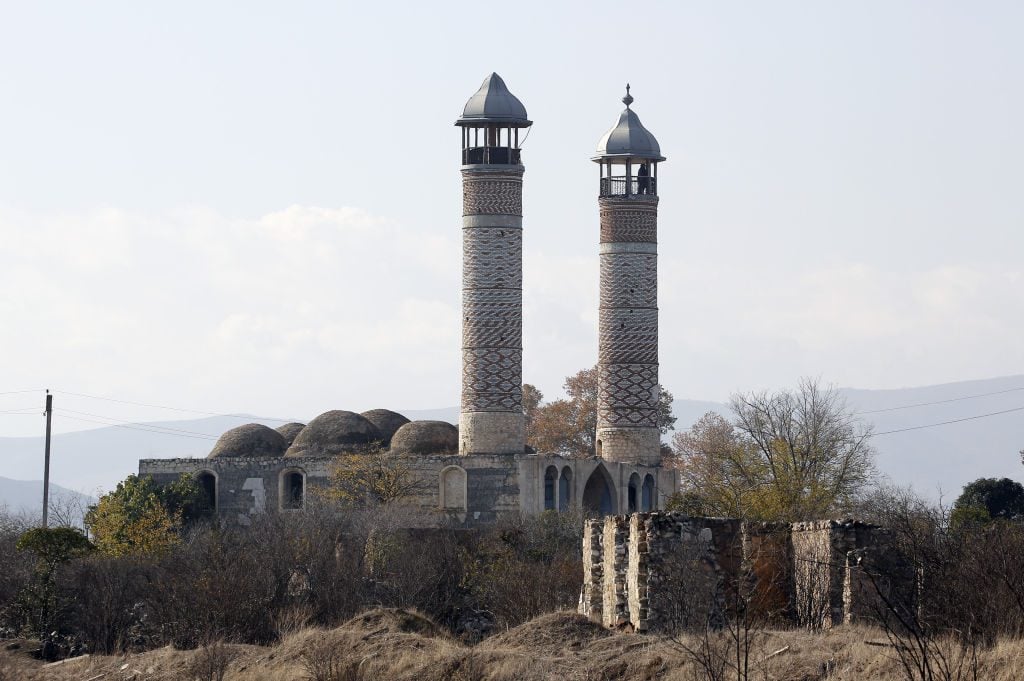
A view of Agdam mosque which was transferred to Azerbaijan after 27 years under Armenian control, is seen in Agdam, Azerbaijan on November 27, 2020. Photo: Murat Kaynak/Anadolu Agency via Getty Images.
What Could the Future Deliver?
The issue is within the purview of international mediators. UNESCO put out a statement expressing its intention to send out a “field mission” to the region. But UNESCO is constrained by its mandate, which gives strong veto powers to nation-states within the organization.
More must be done. It will be helpful if international scholars take up the issue and work to compile an inventory of monuments. They could also collaborate to produce a short and, crucially, objective history of this region for the service of international organizations that rises above any narrow nationalist agendas.
Younger Armenian and Azerbaijani scholars, many of whom have studied abroad and aspire to international academic standards, can also do a great deal if they dare to break nationalist taboos on Armenian-Azerbaijani history. They can re-echo the message that the rich cultural heritage of the South Caucasus long pre-dates the conflicts between these modern nation-states. We must remember that modern Armenia and Azerbaijan are but a blink in the eye in the vast history of this ancient region.
Thomas de Waal is a senior fellow with Carnegie Europe, and author of Black Garden: Armenia and Azerbaijan Through Peace and War.
